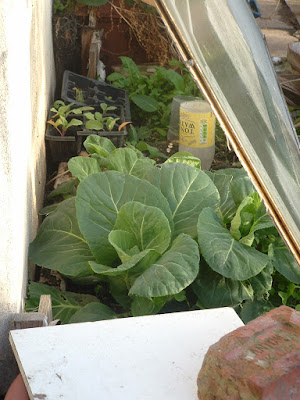 |
| Artichoke sprouting from the base, Dec 2017 |
Roots
Pulled up half the celery in December, half still in the ground mostly unfazed by frost and light snow. The harvested plants filled up a drawer in the fridge and lasted us the rest of the month--very crisp and tasty.
Harvested half the remaining beets in ground at the same time as that celery: about seven small roots. Enough for two bites each--very tasty. The rest of the beets are growing very close to the rest of the celery, so I left them for now (think they're as small or smaller than those harvested).
Seems like some of the garlic and shallots have sprouted; I mulched them with leaves and garden debris early in the month and it's hard to tell.
Mulched 2017's Roots bed thickly with used chicken bedding (manure and straw), as it will be 2018's Misc bed.
Peas and beans
Broad beans growing slowly, some putting out their first leaves now.
Brassicas
Winter and spring cabbages and summer cauliflowers growing slowly; a small amount of outer leaves harvested from the winter cabbages this month.
Had the half of the entire Brussels sprouts harvest for Christmas dinner: small but tasty. The remaining half are much smaller.
Mature kale and sprouting broccoli plants still growing strongly, but young kale seems to have disappeared: probably renegade chickens.
Miscellaneous
Harvested the last two small pumpkins early in the month, grown in planters next to the house.
Leeks still growing, but none harvested.
Too cold now for winter lettuce, and chickens helped themselves to most of the miners lettuce, chard and arugula.
Gave up on forced chicory, although the plants are still alive with a little growth.
As mentioned in Roots above, generously mulched 2018's Misc bed with chicken bedding.
Potatoes
Finished off the last of the potatoes in storage--of the entire harvest, only had to throw out one bad/moldy potato, and the rest were still very tasty right to the last.
Fruit
All fruit dormant now. Lightly pruned Sparta apple tree.
Perennials and herbs
Artichokes sprouting from the base--hope they survive the frosts and cold we've been having this winter.
Early in the month I put a stake next to each (now dormant) asparagus seedling to mark its position for future reference.
All other perennials dormant; all herbs dormant too.







